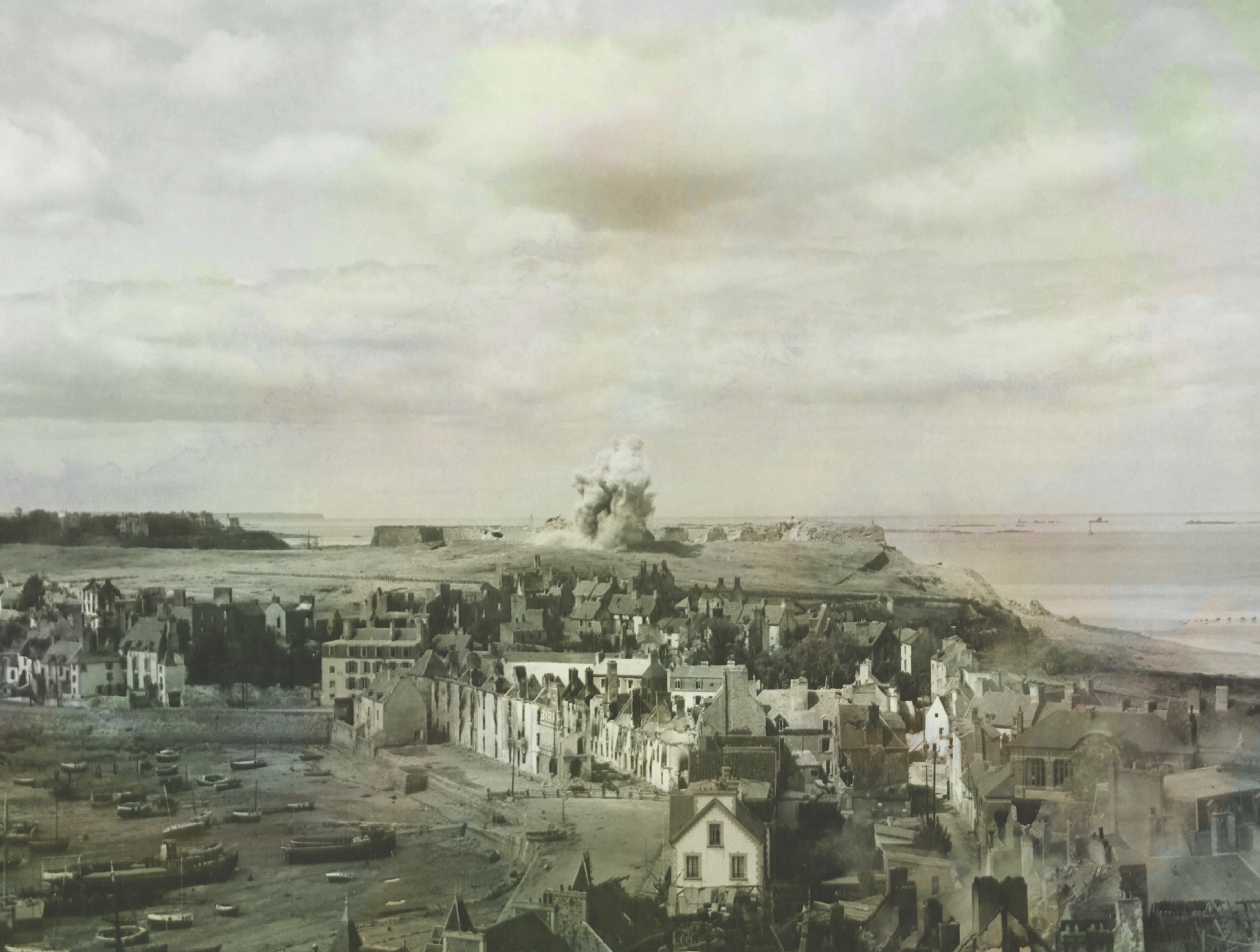Adolf Hitler saw Saint-Malo as a linchpin of the Atlantic Wall. The Allies reduced it to rubble.
ONE MONTH TO THE DAY AFTER ALLIED FORCES LANDED ON THE BEACHES OF NORMANDY on June 6, 1944, Lieutenant General George S. Patton arrived in France to take command of the newly formed U.S. Third Army. Patton was already in a bad mood. He did not agree with Supreme Allied Commander Dwight D. Eisenhower’s plan to have him drive west with his armored divisions to liberate the “Emerald Coast” ports of Brittany, which invasion planners had decided were vital for supplying the massive Allied advance. To Patton, the race to Paris and Germany was paramount. Why waste time freeing a few unimportant French seaports? But he now reported to Lieutenant General Omar Bradley, Eisenhower’s strong right hand, and Bradley insisted that no German strongpoints be left in Patton’s rear. Accordingly, the D-Day planners decided that one of Patton’s three corps had to first capture Brest, the westernmost port in France, and the Nazi U-boat bases at Lorient and Saint-Nazaire before he could propel his armored divisions east.
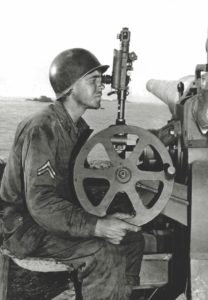
For a hard driver and inveterate glory hound like Patton, the delay was maddening. Still, he had grown used to waiting. It had been almost a year since he had commanded troops in battle, and his boiling temper had almost cost him his career nearly a year earlier when he had impetuously slapped two privates at army hospitals in Sicily. The men were suffering from documented cases of battle fatigue (today known as posttraumatic stress disorder), as well as physical ailments, but Patton refused to believe there was such a malady as “shell shock.” To him, the young soldiers were merely trying to avoid combat. Eisenhower, who had known Patton since the early 1920s when they were lieutenant colonels in the peacetime army, glossed over the incidents in the press but ordered Patton to apologize to the soldiers, their doctors and nurses, and the entire assembled army. At the same time, he removed Patton from active duty and promoted Bradley over him in the run-up to the D-Day invasion. Patton was reduced to commanding a phantom army in England and serving as a well-publicized decoy for a supposed invasion of northern France at Pas-de-Calais in July 1944—a month after the real landings in Normandy were scheduled to take place.
The ruse worked. German field marshal Erwin Rommel, Patton’s old adversary in North Africa who was now in charge of defending France, kept his entire crack Fifteenth Panzer Army waiting fruitlessly at Calais. But Patton chafed at his noncombat role. “Jesus only suffered one night but I have had months and months of it, and the cross is not yet in sight, though probably just around the corner,” he complained to his daughter Ruth Ellen. And to his wife, Beatrice, Patton declared: “Can’t stand the times between wars. I seem destined to either fight like hell or do nothing. I would serve under the devil to get into a fight.” As he frequently did when he was bored and underused, Patton got into trouble again, giving a speech to a British women’s club in which he declared that it was the destiny of the Anglo-Saxon race, specifically Great Britain and the United States, to rule the postwar world. He grudgingly appended the Soviet Union to the formulation, but some newspapers failed to report that addition despite the fact that the Russians at the time were bearing the brunt of the horrific fighting on the Eastern Front.
Once again there were calls for Eisenhower to sack Patton, and this time Ike was ready to do it. “Patton has broken out again,” he informed Army Chief of Staff George C. Marshall in Washington. “Apparently he is unable to use reasonably good sense.” Marshall agreed in principle with Eisenhower but urged him to reconsider, noting “the unmistaken fact that Patton is the only available Army commander for his present assignment who has actual experience in fighting Rommel and in extensive landing operations followed by a campaign of rapid exploitation.”
After keeping Patton in suspense for several weeks, Eisenhower relented. “I have decided to keep you,” he cabled. “Go ahead and train your army.” Patton thanked Eisenhower effusively and exulted in his diary, “I have completely gotten back in the swing of things, thank God.” On arriving at a U.S. airstrip on Omaha Beach, he leaped atop a jeep and told a crowd of waiting soldiers: “I’m proud to be here to fight beside you. Now let’s cut the guts out of those Krauts and get on to Berlin.” He promised to take one of his famous ivory-handled pistols and personally shoot führer Adolf Hitler “just like I would a snake.”
For the Allied forces seeking to enlarge their hard-won toehold in France, Patton’s return came not a moment too soon. The Allied advance had literally bogged down into a painful yard-at-a-time slog of hedgerow fighting against heavy resistance through the flooded fields of the Cotentin Peninsula, where tanks were all but useless. By August 1 Patton was finally ready to lead a major drive into adjoining Brittany. Spurring his army through the Avranches–Pontaubault Gap on a two-lane road at high speed, he pushed 200,000 men and 40,000 vehicles into Brittany in 72 hours. “We are advancing constantly,” he told his staff. “From here on out, until we win or die in the attempt, we will always be audacious.” When traffic inevitably snarled on the overcrowded road, Patton jumped onto a police box at a jammed roundabout and, for an hour and a half, waved his forces through.
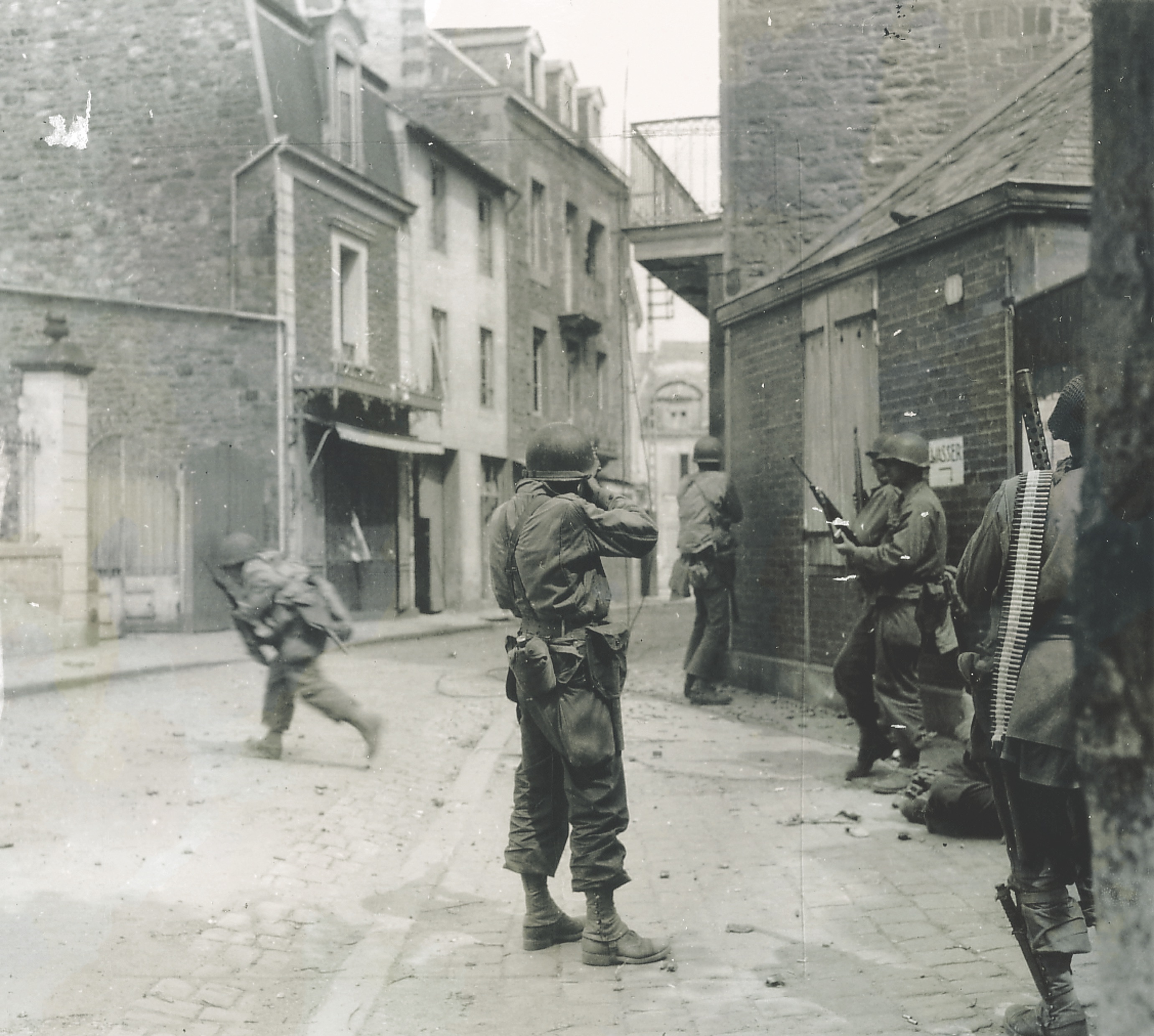
Peeling off the 6th Armored Division, Patton sent it racing toward Brest, a critical hub for the reinforcement and resupply of American troops. He then formed Task Force A, assigning 3,500 men from cavalry, engineering, and tank-destroying units to follow the northern coastal road, bypassing port towns and securing key bridges on the vital Brest–Rennes rail line before the retreating Germans could destroy them. As might have been predicted, the two American forces quickly outran their communications. Not waiting for infantry support, Task Force A, assuming that the armored division had gone ahead, turned a bend in the tree-lined road near Dol-de-Bretagne on August 3 and rolled headfirst into an ambush by German antitank guns, machine guns, and mortars. The lead jeep burst into flames, and the cavalry commander was killed. Task Force A’s overall commander, Major General Herbert Earnest, radioed for help. “Please reply, need urgent,” he pleaded. “Rush troops.”
Patton had assigned Major General Troy H. Middleton, a seasoned ground commander, to lead VIII Corps in Brittany. Patton discounted French resistance reports that nearby Saint-Malo was heavily fortified and defended by more than 12,000 Germans. American intelligence estimated 3,000 enemy troops. Patton, expecting only token opposition, ordered the 83rd Infantry Division to ignore Saint-Malo altogether, leaving it to be isolated by Task Force A while the infantry followed his armored division to attack Brest. “There aren’t more than ten thousand Krauts in the entire peninsula,” he assured his subordinates. But as the task force approached the historic walled city on August 4, it was bombarded by German heavy artillery. Alarmed at the unexpected concentration of enemy troops, Middleton set aside Patton’s orders and recalled a regiment of the 83rd to probe the German defenses. When the regiment reported that it had met stiff resistance, Middleton ordered the entire division to reverse course and clean out the Germans at Saint-Malo.
SAINT-MALO, A FORTRESS THE GAULS BUILT ON A MASSIVE ROCK OUTCROPPING IN THE FIRST CENTURY BCE, was settled over the next five centuries by Celts fleeing instability in Roman Britain. Named for its patron saint, the Welsh immigrant priest Maclou, the port city served as the main base for Celtic missionaries to Ireland and Brittany. In the 16th century Jacques Cartier, a Malouin (a native of Saint-Malo), launched the first French expedition to explore Canada with ships outfitted by wealthy merchants who were eager to expand a trading empire that already extended to the Arabian Peninsula, the Indian Ocean, Chile, Rio de Janeiro, and the South Atlantic. With their riches these corsairs, functioning in wartime as the king’s privateers, had constructed lavish mansions inside ramparts linked to the towering 15th-century donjon of Duchess Anne of Brittany, twice queen consort of France. King Louis XIV’s celebrated military engineer, Sébastien le Prestre, comte de Vauban, designed a network of offshore forts that repulsed several British naval expeditions.
By the late 19th century, Saint-Malo’s crescent of wide beaches had become adorned with the summer homes of wealthy Parisians attracted by a flourishing casino and stylish hotels habituated by European royalty, including French emperor Napoleon III, who donated a new steeple to the city’s Cathedral of Saint Vincent of Saragossa. At its spas and fashionable cafés, vacationers could rub elbows with such celebrities as the writers Colette and James Joyce and the Malouin actor Colin Clive, star of the blockbuster horror movie Frankenstein.
All that ended in June 1940 when German forces occupied Saint-Malo and turned the resort into one of five Brittany ports Adolf Hitler designated as festungen, or fortresses, intended to thwart any Allied invasion. Beginning in July 1942, thousands of conscripts from forced-labor camps were detailed to Organisation Todt, the Nazi engineering and construction operation, and made to work night and day building concrete bastions, implanting them with heavy guns linked by telephone to coordinate enfilading fire. In addition, Saint-Malo became a naval base for a flotilla of German minesweepers, corvettes, and gunboats that menaced Allied shipping in the English Channel. Hitler expected all his festungen to hold out for at least 90 days after an Allied invasion, time enough for his new super weapons—V-1 and V-2 rockets, “oyster” mines, Me 262 jet fighters, new super tanks, and Mark XXI submarines—to become fully operational.
On Cézembre, an island three miles from Saint-Malo, the Nazis placed six 194mm railroad guns with a 10-mile range, one 150mm cannon, six 75mms, and batteries of antiaircraft guns to protect the mouth of the Rance River. Naval gunners took their orders from headquarters on Jersey in the Channel Islands. When Rommel came to inspect Saint-Malo’s sector of the Atlantic Wall in February 1944, he made one suggestion: Turn Cézembre’s 194s around to fire landward, where Rommel was sure an enemy attack would come. It was good advice.
A string of forts lined the bay of Saint-Malo, including the 18th-century Fort National designed by Vauban to further protect the port from assaults across the English Channel. The strongest works took shape out of sight, deep inside a promontory across the main harbor from Saint-Malo. For more than a year, as many as 2,200 German conscripts labored night and day, reinforcing the Cité d’Aleth citadel with 20-foot-thick walls and equipping it with a railroad to shunt ammunition and supplies to its 32 bunkers, gun emplacements, hospital, barracks for 600 men, and a command post linked by telephone to Cézembre and the other forts to coordinate fire control.
In his spartan quarters six stories belowground, German colonel Andreas von Aulock, an expert in urban warfare, directed Saint-Malo’s defense. Hitler himself had picked von Aulock to hold the fortress. A survivor of the yearlong Battle of Verdun in World War I and an Opel automobile executive afterward, von Aulock had taken part in the invasion of Poland and the brutal siege of Stalingrad. In the Crimean campaign, as commander of the 179th Division, he had fought so fiercely that Hitler had awarded him the Third Reich’s highest honor, the Knight’s Cross of the Iron Cross with oak leaf clusters. Though disappointed to be guarding a static fortress rather than leading a division of mobile troops, von Aulock vowed to make Saint-Malo “another Stalingrad.” He told his staff: “I will execute the orders I have received, and doing my duty as a soldier, I will fight to the last stone.”
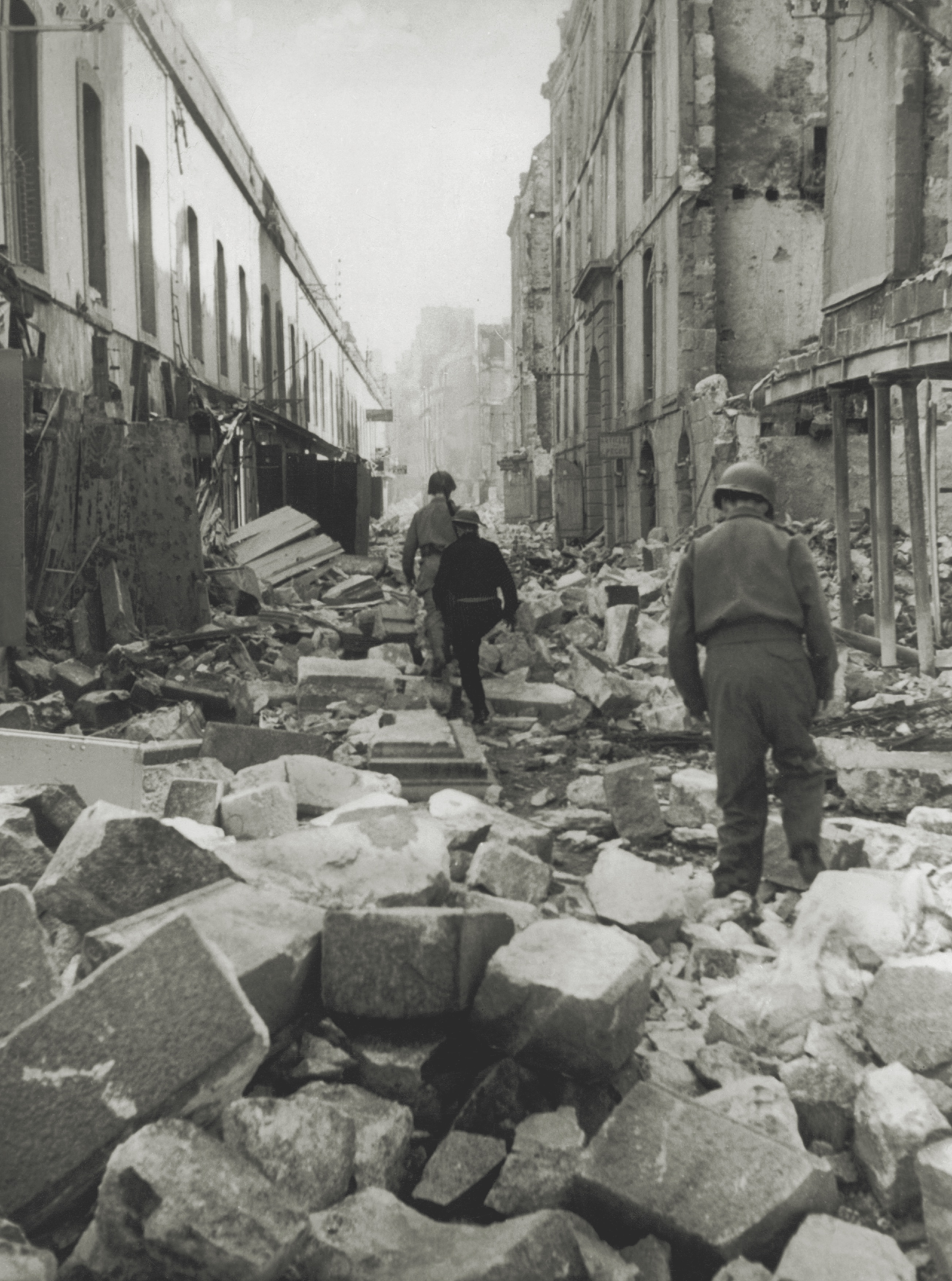
No preening Nazi martinet, von Aulock generally treated the citizens of Saint-Malo with respect. After the D-Day landings, he advised them to evacuate the town, which he was sure was about to become a battleground. But most residents chose to remain where they were, despite the obvious danger. Saint-Malo suffered its first civilian casualties on July 17, when British bombers blasted rail yards and fuel depots on the city’s southern outskirts. It suddenly became too late for civilians to flee.
Arriving on the city’s outskirts on August 3, American officers quickly realized that taking Saint-Malo would entail a stubborn infantry fight. Patton, of course, had wanted to ignore it altogether. Bradley, who had at first ordered Saint-Malo captured, reluctantly went along with Patton—Bradley had little choice, short of sacking his impulsive commander. But Middleton, a career soldier who as a young lieutenant had once skirmished with Pancho Villa’s guerrillas in Arizona, felt it inadvisable to leave the Nazi stronghold unscathed in their rear. Despite being called “apathetic” and “dumb” by Patton for not moving quickly enough to take Brest, Middleton directed newly promoted major general Robert C. Macon to take his 83rd Infantry Division and capture Saint-Malo in conjunction with Task Force A.
On August 4, the entire 83rd Division assembled at Pontorson. The next day, the 330th Infantry Regiment, supported by artillery, captured Dol-de-Bretagne, the 329th passing through it to capture Miniac to the west. All three regiments, with air and artillery support, now attacked abreast, from Pointe de la Varde at the eastern tip of the crescent-shaped bay to Saint-Malo’s ramparts and west across the Rance to Dinard. All the approaches to the Saint-Malo peninsula, they soon found, were bottlenecks of canals, ponds, and swamps. Every approach to the walled city was covered by prearranged artillery, mortar, and rocket fire, with shells exploding from minesweepers offshore and whistling in from Cézembre.
As the men of the 330th moved out on the right from Dol-de-Bretagne along the Saint-Malo–Rennes railroad line, they discovered that all the bridges across the canals had been destroyed, limiting access to the peninsula through Châteauneuf, directly south of Saint-Malo, where the 329th and Task Force A encountered bitter resistance as they came under heavy fire from the naval guns. The riflemen of the 331st, fanning out to the east toward Pointe de la Varde, ran into belts of barbed wire, minefields, and double rows of steel gates covered by enfilading fire from machine guns in hidden pillboxes as well as heavy fire from Cézembre and German minesweepers offshore.
Moving up from the south, the 329th made slow progress through mortar and machine-gun cross fire from pillboxes that inflicted heavy casualties. At Saint-Servan-sur-Mer, across the harbor from Saint-Malo, the 329th captured most of the town after two days of intense house-to-house fighting, stopping only under murderous fire from von Aulock’s citadel, Cité d’Aleth. In the center of the line, the 330th, laying down an artillery barrage, attacked Saint Joseph’s Hill, a high, rocky land mass where 500 Germans had dug in, defending the approaches with machine-gun and mortar fire. To the northeast, the 331st ran into barbed wire and mines and came under intense fire from Cézembre and enemy gunboats off Pointe de la Varde.
ON AUGUST 5, AFTER BRITISH BOMBERS TARGETED THE CASINO IN Paramé, knocking out its cluster of antiaircraft guns, a civilian delegation asked von Aulock to declare Saint-Malo an open city. He replied that he lacked the authority to do so but promised to pass along the plea to Hitler. Hitler responded quickly: In war, he said, there was no such thing as an open city. Hitler ordered von Aulock to “fight to the last man.” Von Aulock’s response: “I will defend Saint-Malo to the last man, even if the last man has to be myself.”
The next day von Aulock ordered all civilian Malouins except gendarmes and firefighters to evacuate Saint-Malo and find shelter outside a 10-mile perimeter that he had designated as the combat zone, roughly the field of fire of the guns of Cézembre. Some 5,000 residents of the city walked into the American lines under white flags. Another 2,000 residents failed to comply. Aulock ordered the holdouts to stay in their cellars, where many lacked water or light, and directed that all cafés and businesses, except four bakeries, be shuttered.
On the pretext that the French Resistance was using the tower of the 12th-century cathedral as a forward observation post to help the Americans, the captain of the German corvette Breithaupt ordered his gunners to open fire on the city for the first time, shooting off the cathedral’s steeple and sending it crashing with its heavy bells down onto the tomb of Jacques Cartier, the famous French explorer. The Malouins saw it as a bad omen. So did von Aulock, who told the ship’s commander that the shelling had “hardly covered the German navy with glory.”
That same day, fires began breaking out in the city. Malouins believed that Germans had accidentally started them by spilling gasoline as they burned official documents. Schutzstaffel troops set other fires deliberately and prevented firefighters from putting out the blazes. The next morning, on von Aulock’s orders, 97 preset mines were set off, destroying the city’s docks and canal and sinking every civilian ship in the harbor. In response, American forces brought their artillery to bear on the German defenses. For the first time American mortars fired from the hills behind the city, striking Place Châteaubriand, site of the commandeered Hotel Châteaubriand, headquarters of the despised Gestapo, and setting nearby apartment buildings on fire.
A six-day artillery duel began.
Misinformed that local “terrorists” had fired on German troops, von Aulock ordered the arrest of every male age 17 to 70. At low tide, under armed escort, 382 hostages were marched to the offshore Fort National to be held as hostages. The fort afforded no shelter, no food or water. All night, as the bombardment continued, the hostages remained exposed on the terrace, huddling against its walls. American gunners, mistakenly believing that the fort was held by German troops, fired phosphorous mortar rounds into it, killing 18 civilians.
Gendarmes and firefighters released on von Aulock’s order were sent back to fight the fires now raging through centuries-old timbers inside the city. But there was no water. German offshore guns had struck the pipes that carried water from reservoirs above the city, and von Aulock refused to permit the firefighters to pump water from the bay. (The beaches, heavily mined, remained off limits to civilians.) Ultimately, as 17 separate fires raged, the helpless firefighters were hustled back to the Fort National. Gigantic plumes of smoke obscured the city’s famous spires.
In a brief lull in the fighting, Patton arrived on the scene. He wanted the 83rd to mop up the Germans and hurry on toward Brest. The division, he said, had been “doing well, but not too well.” He began to scold Macon for not pressing the attacks more vigorously. “General,” Macon tactfully explained, “if you just move up there forty yards, you will be inside the enemy front line!” Patton scoffed that “the fighting had degenerated into a sniping contest. Not much noise but dangerous to stick one’s neck out.” The next day the 908th Field Artillery arrived with 105mm howitzers and began to fire directly into von Aulock’s citadel at Cité d’Aleth.
While the 83rd was attacking Saint-Malo, across the Rance the newly arrived 121st Infantry was assaulting Dinard, a clifftop resort long favored by British aristocrats, including Prime Minister Winston Churchill. As the 121st approached, it received heavy artillery fire and encountered camouflaged blockhouses and underground pillboxes. American artillery proved ineffective. A battalion of the 121st was cut off and surrounded. Desperate efforts to relieve it failed; five small observation planes attempting to drop plasma were shot down. Not until Saint Joseph’s Hill fell could Macon send the 331st Regiment across the Rance to help the besieged battalion, its crossing slowed by still more heavily fortified strongpoints. By the time the battalion was relieved, 31 of its men had been killed and 106 wounded; another 11 were missing in action.
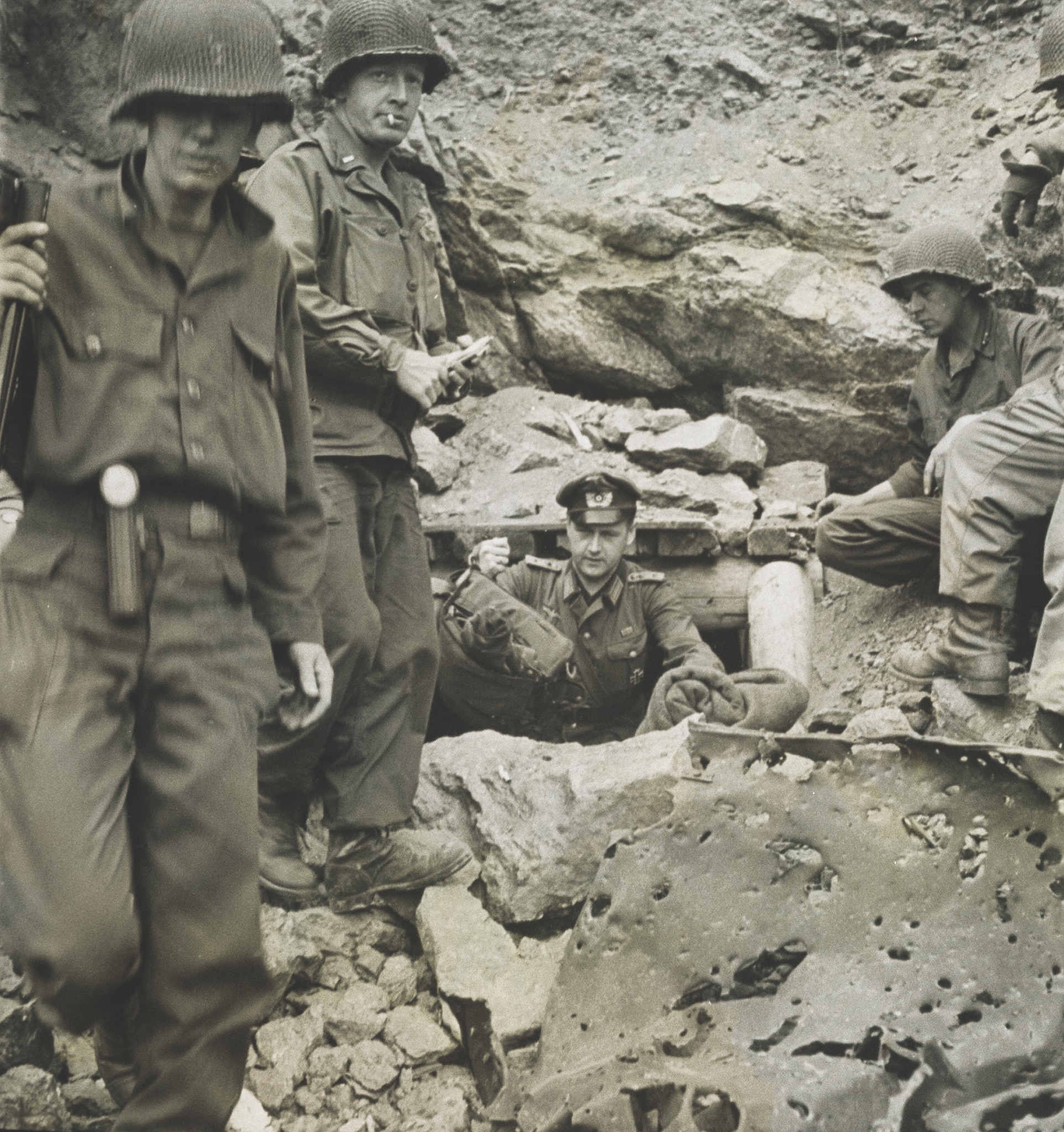
INSIDE DINARD, GERMAN COLONEL RUDOLF BACHERER COMMANDED A FORCE of experienced veterans of the 77th Infantry Division, among them many survivors of the fighting at Normandy and the Cotentin Peninsula. When Macon sent Bacherer an ultimatum to surrender, he refused. “Every house must become a fortress, every stone a hiding place, and for every stone we shall fight,” Bacherer declared. Macon increased the pressure, sending two full regiments and mortars against Bacherer. After five days of bitter fighting, the 331st Infantry finally broke through the German lines. Methodically destroying one pillbox after another, the two American regiments cleared the surrounding villages and captured Bacherer along with 400 of his men.
As aerial bombardment of German forts around Saint-Malo intensified and a thick pall of smoke covered the city, the 329th Infantry attacked German strongpoints to the east. It took a three-day artillery bombardment and two battalions of infantry fighting pillbox by pillbox to reduce Saint-Ideuc before another 160 Germans surrendered. The next day, the assault on Fort de la Varde yielded 100 more prisoners. The 329th finally fought its way into Paramé on August 11, but army engineers had to blast holes in the stone seaside mansions to allow hand-to-hand fighting. What remained of the casino garrison then surrendered.
Across a 1,000-yard causeway lay the massive, cement-reinforced donjon. Its German garrison refused to yield to waves of Allied bombers and 8-inch shells; its batteries of antiaircraft guns remained unscathed. The tower sheltered some 200 wounded Germans; von Aulock allowed two civilian doctors to go to the American headquarters in the beachfront Hotel Franklin to seek morphine. The Americans agreed to a two-day truce, provided the requested morphine, and not incidentally learned from their French emissaries how few Germans actually held the tower.
On August 14, under a smoke screen after a massive bombardment, the 331st rushed across the causeway and through Saint Vincent’s Gate into the burning city. Late that afternoon the Germans in the tower surrendered; only 85 combatants were left inside the intact fortress. American infantry hurried offshore to find Fort National deserted, then waded across to the Grand Bé, a tidal island at the mouth of the Rance River, and without a fight captured the small garrison huddled around the tomb of native Malouin novelist-diplomat Francois-René de Châteaubriand.
That night, as Sherman M4 tanks entered the city, German coastal guns shelled them, igniting yet another fire along the south rampart of the city and destroying the palatial home of René Duguay-Trouin, the famous 17th-century French admiral and king of the corsairs. German artillery fire intensified. With the support of Cézembre’s guns, the defenders inside Cité d’Aleth were able to ward off attack from any direction. The fort’s 20-foot-thick walls, constructed of stone, cement, and steel, were capable of withstanding high-explosive bombs and the heaviest shelling; its exterior was lined with steel rails and heavily mined and guarded by cross-firing machine guns and 20mm guns. Though the fort was pounded by 8-inch guns and 240mm howitzers from 10 American artillery battalions, von Aulock refused three times to surrender. He continued to hold out for a German counter-offensive, admonishing his men that “a German soldier does not give up.” Anyone who did, he said, was nothing but “a common dog.”
Allied planes dropping incendiaries and armor-piercing bombs preceded a ground attack by 30 American riflemen accompanied by Free French soldiers and engineers. Scaling the walls and reaching the interior courtyard, they could find no damage from the bombing. They dropped pole charges down ventilator shafts but were forced to retreat by shells from Cézembre and the cross-firing German machine guns. For the next two days tank destroyers, 105- and 155mm howitzers, and an 8-inch gun fired 4,000 rounds directly into gun emplacements to no effect. On August 15, after another aerial bombardment and another failed infantry attack, Macon called for a joint bombardment by medium and heavy bombers dropping 500- and 1,000-pound and incendiary bombs to no effect. On the ground an array of artillery, including two 8-inch guns, fired at 1,500 yards into portholes and vents as infantry braved machine-gun and mortar fire, suffering heavy casualties.
On the morning of August 17, Colonel Seth McKee of the 370th Fighter Group took off from an airfield at Calvados with a squadron of modified Lockheed P-38J Lightning dive-bombers. Their wingtip auxiliary fuel tanks carried a new experimental weapon, jellied gasoline, later known as napalm, designed to be ignited by phosphorus grenades. Developed in a chemical weapons laboratory at Harvard University in 1942, napalm had never before been used in combat. McKee, who would fly 70 combat missions in World War II, led the attack on the German bastion. Making a steep dive, he dropped a single tank of napalm directly down a ventilator shaft. Within minutes, a white flag appeared and 605 Germans, including von Aulock, poured out. The burning gel had instantly consumed all the oxygen in the fortress. Seeing the white flag behind him as he climbed, McKee veered off to lead the squadron in depositing the rest of the napalm on Cézembre.
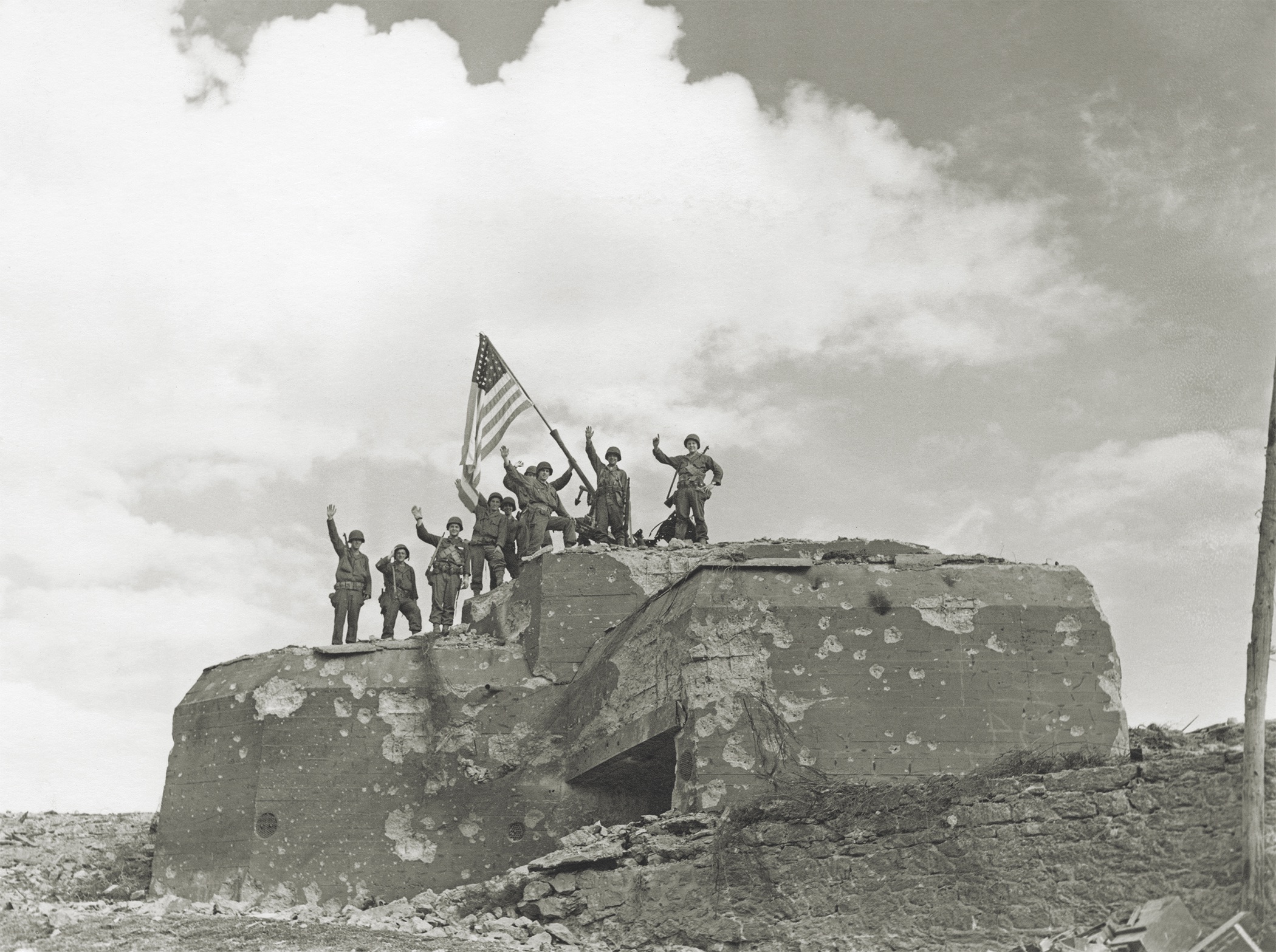
JOURNALIST MONTAGUE LACEY OF THE LONDON DAILY EXPRESS WAS ON HAND FOR von Aulock’s surrender. He was not impressed. In his rendering of the capitulation scene, von Aulock became “the mad colonel with a monocle and a swaggering walk” who “goose-stepped up to surrender with a batman carrying his large black suitcase, and another in attendance round him flicking the dust from his uniform, and as they went by an American soldier called out: ‘What a corny show!’” According to Lacey, French townspeople gathered around, shouting and shaking their fists at the German prisoners. “As the Germans pile into trucks to be taken away,” he added, “the older men somehow look ashamed and stupid, but the young Germans are still grinning and arrogant.”
On Cézembre, not even the burning napalm persuaded Lieutenant Richard Seuss of the 608th Battalion Naval Artillery to surrender, even after two meetings with American officers. Seuss insisted that he would not relinquish the last German post on Brittany’s northern coast until he received direct instructions from his commanding officer on Jersey. That would require another two weeks. Meanwhile, the merciless bombardment continued. After weeks of delay, as the rest of the American forces finally swept west toward Brest, Cézembre was left isolated. The British World War I–era battleship Warspite dropped anchor offshore and fired hundreds of 15-inch rounds; some 300 Allied bombers dropped 19,729 bombs that left 2,000 craters measuring 6 feet or more in diameter. On September 1, in a single day, 2,400 heavy bombs shook Cézembre.
At last a bomb struck the island’s desalinization plant: Deprived of water, Seuss was forced to surrender his 400-man garrison. (He would later receive an Iron Cross for gallantry from Hitler.) The last resistance by Festung Saint-Malo had ended, six weeks after the first British bombing raid and exactly one month after the arrival of the 83rd Infantry Division. Patton had expected token resistance from a few thousand Germans. Instead, after taking and sustaining heavy casualties, some 9,025 Germans surrendered. To his manifest irritation, Patton hadn’t been allowed to race with his armored divisions toward Paris. In that way, at least, von Aulock had something to show for his stubborn stand at Saint-Malo.
Of the 865 existing buildings inside historic Saint-Malo, only 182 remained standing after the battle, and all of them had been badly damaged. It would take 12 years for the historic city, on the orders of President Charles de Gaulle, to be meticulously restored—one numbered stone after another—and again became a favorite French resort. It would take another dozen years for the lingering phosphorus atop Cézembre to dissipate enough for experts to safely study the island. The war, if not the city’s German occupiers, was a long time leaving Saint-Malo. MHQ
Willard Sterne Randall, professor emeritus of history at Champlain College, is the author of 14 books, including Unshackling America: How the War of 1812 Truly Ended the American Revolution (St. Martins Press, 2017). Nancy Nahra is professor emerita of humanities at Champlain College. Husband and wife, Randall and Nahra are frequent coauthors.
[hr]
This article appears in the Summer 2019 issue (Vol. 31, No. 4) of MHQ—The Quarterly Journal of Military History with the headline: Assault on the Citadel

Want to have the lavishly illustrated, premium-quality print edition of MHQ delivered directly to you four times a year? Subscribe now at special savings!

